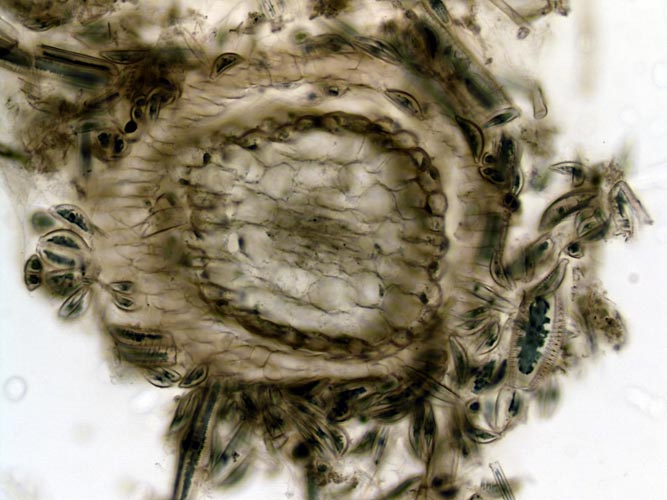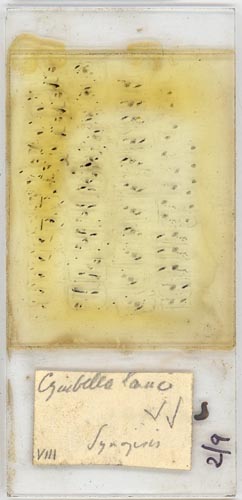
The Geitler Collection: serial section slides

Plön slides used for research into the auxosporulation and meiosis of Cymbella lanceolata
Most of the slides in Box 2 in the Geitler Collection are large format slides (75 × 35 mm), usually with an irregular paper label gummed onto one end. The mountant is Canada Balsam. They were prepared in autumn 1925, according to Geitler (1927), who used them to document copulation, meiosis and auxospore formation in Cymbella lanceolata.
Inspection of the slides by eye revealed that some (including the slide shown here) bear regular patterns of spots and streaks, and examination with the microscope showed that these marks are in fact transverse, oblique and longitudinal sections through higher plant roots. Furthermore, it can often be seen that each repeating unit within the pattern is contained within a slightly more opaque grey rectangle. It is clear that such preparations comprise series of serial sections through the roots of Phragmites. Geitler wrote: "Ich fand damals im Großen Plöner See auf den frei ins Wasser ragenden Wurzeln von Phragmites communis in großer Individuenzahl copulierend Cymbella lanceolata.... Nach einer nur provisorisch gedachtem Lebendbeobachtung wurde der Rest des Material fixiert". Geitler stated that the material was fixed with Schaudinn's mercuric chloride–ethanol mixture and stained using Heidenhain's Iron–Alum Haematoxylin. The use of wax embedding does not appear to be mentioned in his paper, but the microtome sectioning is briefly mentioned in p. 489. No similar preparations by other authors are known to me.
Others of the Plön slides contain material that was apparently stained and mounted without embedding and sectionig.
The epiphytic flora of the Phragmites roots contains many more species than Cymbella lanceolata; indeed, this species is quite rare and a thorough search is needed to find the specimens Geitler studied for his paper. Other species of Cymbella are present, together with species Epithemia, Rhopalodia, Amphora, Gomphonema and others, and some of these diatoms are also in the process of auxosporulation.
An example of a slightly obliquely sectioned Phragmites bearing dense growths of Epithemia and Rhopalodia is shown below.
Reference: L. Geitler (1927) Die Reduktionsteilung und Copulation von Cymbella lanceolata. Archiv für Protistenkunde 58: 465–507.


